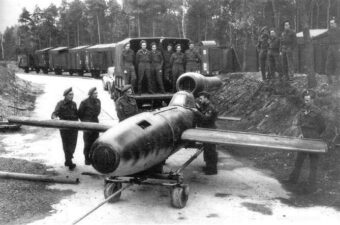“Unveiling the Bizarre: How Nazi Germany Crafted a Wooden Weapon of War That Defied Belief”
Despite this tragedy, the SS pressed on with the project, though the next – and final – 10 test launches were all unmanned. In April 1945, ten aircraft and eight pilots were earmarked for the Natter’s first operational mission, codenamed Operation Crocus. The launch towers for this operation had already been constructed at the end of February in a forest called Hasenholtz just south of Stuttgart. The first missions were scheduled to be flown on April 20 – Adolf Hitler’s birthday – but on that day the U.S. 10th Armoured Division overran the area, forcing the Natter crews to destroy their aircraft and retreat to Waldsee. 18 days later Nazi Germany surrendered, the Natter having never seen combat. Today, only one complete Natter survives at the National Air and Space Museum in Washington, D.C, captured by American troops in Piztal, Austria, in May 1945.
Though the Natter was certainly among the most creative and cost-effective of Nazi Germany’s anti-bomber weapons, even had it been introduced earlier it is doubtful it would have had any impact on the course of the war. The aircraft’s operational range was simply too small, and its immobile launch towers too vulnerable to Allied air attack. And even if German industry, stretched thin as it was, had managed to produce large numbers of Natters, Germany simply had too few trained pilots to fly them. The plain truth was that Nazi Germany had already lost the war, and like all its fellow ‘wonder weapons’, the Natter program was simply a case of too little, too late.












